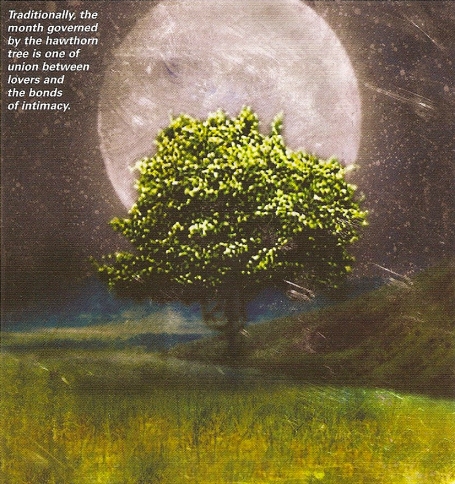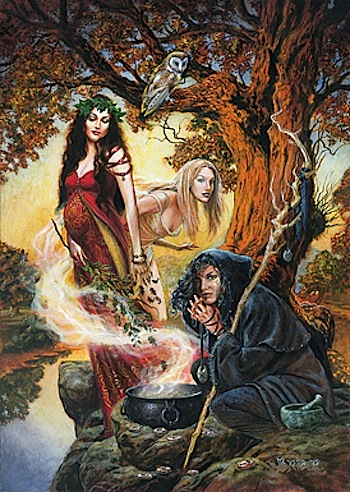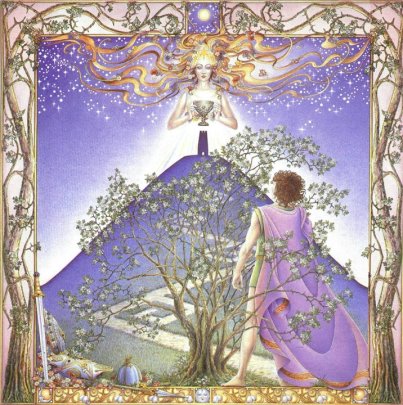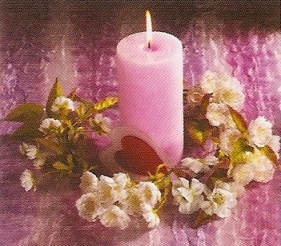
“Mary’s themes are miracles and the sun. Her symbols are the sun (or yellow/gold items) and rosary beads. It is no coincidence that many of the world’s Goddesses have ‘ma’ as part of their name, being mothers of humankind. The virgin Mary became the maiden, virginal Goddess archetype in Christianity, faithfully interceding for people with the gods and attending to our needs.
If you feel like you need a miracle, be sure to wear yellow- or gold-colored items today. As you don each one, say:
‘Mary hear me
Mary see me
Mary free me’
This date commemorates the appearance of Mary in Fatima, where children praying for peace began a cycle of visitors all looking for this Goddess to appear again. According to the story, when seventy thousand people were gathered there on this day, the rain stopped and the sun began to dance for joy as if guided by Mary’s hand. Whenever the sun shines again today, it is a sign of Her blessing.
To make your own prayer beads (to beseech Mary or any Goddess), cook rose petals in a little water in an iron pot until nearly black and pasty. Add a little orris powder and rose-scented oil, and shape the beads to two times the size you want them to be when dry. Pierce them with a needle and string tem, turning them regularly until they’re dry. Bless them in a manner suited to your path, then use the beads to energize your prayers by holding them as you entreat the Goddess.”
(Patricia Telesco, “365 Goddess: a daily guide to the magic and inspiration of the goddess”.)

Judaeo-Christian theology attempted to bury Our Mother God, but She reappears as the Blessed Virgin Mary, capturing the hearts of Her Children.
“It is well known that the earliest human civilizations known to archaeology are dominated by the iconography of the Supreme Mother God [see The Feminine Heritage]. Gradually, as the feminine-centered civilization weakened, She was depicted with decidedly inferior male consorts (often lunar or earthly in symbolism contrasting with the Solar and Heavenly iconography of the Supreme Mother).
Then, as true patriarchy takes hold, the male consort is promoted above God the Mother in an attempt to justify male domination on earth with a newly patriarchal ‘heaven’. The Solar and Heavenly symbolism is transferred to the former consort, while the Our Mother is given the Earth and Moon iconography which had been given to the masculine god in the days of his subordinate status; but which had originally belonged to the Daughter.
Eventually, the pantheons of the world were dominated by male gods with Our Mother God and Her various Aspects and Angelic Emanations being represented by subsidiary figures or “Goddesses”, often married, and subordinate, to “Gods”.
Finally, with the Abrahamic religions, we have a return to the pure monotheism of the earliest times, only this time it is as purely masculine as the original Faith of humanity was purely feminine.
Such, at any rate, was the intention. In reality, at every stage, wherever the patriarchy was not strong enough to suppress it – whenever there was even a momentary break in the patriarchal lockdown – the original faith blossomed again and Her children turned back to Our Mother.
As the Prophet Jeremiah angrily records:
“The children gather wood, and the fathers kindle the fire, and the women knead their dough, to make cakes to the Queen of Heaven.” – Jeremiah 7:18
The women are by no means ashamed of this, but proclaim:
“We will do everything we said we would do. We will burn incense to the Queen of Heaven and pour out wine offerings to Her.” – Jeremiah 44:17
The Queen of Heaven! Let us note how gloriously Our Mother returns! From the rigid exclusion of Her attempted by the patriarchy, the people do not move shamefacedly back to depicting Her in Her intermediate status as a subordinate Earth Goddess. No, She is the Queen of Heaven, as She was in the beginning.

“The Crowning of the Virgin by the Trinity” by Diego Velázquez
The very words ‘Queen of Heaven’ are an abomination to the prophet. Who, then, would have imagined that a thousand years later, followers of the most widespread branch of the Abrahamic faith would return officially to the worship of the Queen of Heaven? Yet this is the very title given to the Blessed Virgin Mary.” [1]
Mary Protectress, Mother, Goddess & Saint

“Mary is celebrated around the world as the Divine Feminine by millions of people, many of them Catholics. Those who are devoted to Mary, honor Her as the mother of Jesus. The Blessed Virgin Mary is known as the dispenser of mercy, the ever patient mother, and protectress of humanity, and special protectress of women and children.
Many believe that with the rise of Christianity and papal power, the Goddess slowly disappeared from western culture and faded into the Mists of Avalon . . . So great was devotion to the Goddess that She was resurrected in the hearts of the people by a new Goddess, Mary, Mother of Jesus, the Christian version of the Green Man.
Officially, the Catholic Church teaches that Mary was mortal and is not a Goddess, but despite this official position, many Catholics honor Mary as a Goddess. Other Catholics revere Mary as Mother of Jesus, but not as divine.
Visions of the Virgin Mary have appeared to thousands of people around the world. Her sacred shrines are at Lourdes in France and Guadalupe in Mexico, as well as many other places. Her apparitions are often to children.


Reconstruction of the Temple of Artemis
Mary was declared to be the ‘Mother of God’ by the Christian church in the 7th century at Ephesus, Turkey. Ephesus was the home of a magnificent temple to the Goddess, Artemis Diana, one of whose sacred titles was ‘Queen of Heaven’. Mary is a more recent and much loved incarnation of the Great Goddess of the ancient Middle-eastern cultures. Mary shares many standard Goddess attributes and symbols.
The Christian church also conferred the Goddess’s title on the Mother of Jesus. They called Her, ‘Mary, Queen of Heaven‘ and ‘Mary, Queen of the Angels’ both are very ancient titles of the widely worshipped Great Goddesses on the Middle-east.

Isis suckling Horus
The Madonna and child have been revered since the earliest times. Isis and Her son Horus, Mary and Her son Jesus, Demeter and Her daughter Kore, all have attracted a devout following. Long before Isis, and long before Mary or Demeter, the human psyche fashioned Madonna and child icons and placed them in sacred shrines. In ritual caves and worshipped the icons as sacred representation in sacred groves, to honor the Mother & Child. Mary is always shown wearing a head covering like Muslim women today, a head covering was required for women throughout Christian history. In 1983 the rule requiring woman to cover their hair in Church was omitted from the updated official revised Catholic Canon pertaining to such matters.

Through time, the names and sometimes the images of the Madonna and child have changed, but the location of these shrines and the wide devotion to them has remained constant. in many cultures. Image of the Madonna & Child are central to Catholicism, as they were often central to the Pagan worship of the Goddess Isis and other Goddesses in the ancient world. Below are Demeter and her daughter Kore.

Demeter and Persephone / Kore

One of the most beloved images in all Christianity is The Black Madonna. Devotion to the Black Virgin has never been stronger; Her shrines attract thousands of worshippers each year. The Black Madonna is revered throughout the world, particularly in France, Poland, Italy, and Spain. She is the Blessed Virgin Mary of the Crusades and holy pilgrimages. There are thousands of these beautiful sacred Madonna Icons.
The Black Madonna is honored as a true Goddess figure, and has been since Christianity entered Europe. She is honored by many as Isis, Gaia, Kali, Mary, “the Other Mary” (Mary Magdalene), Diana, Sheela Na Gig, and the Ancient Primal Earth-Mother Goddess. All are beloved all are revered; each region has their own traditions.

For many European Christians, the blending of their ancient Goddesses with the Blessed Virgin Mary has been a well-accepted fact of their faith for centuries, there is no conflict. The holy Black Madonna, be She called Isis, or Mary, or Kali, or Diana, embodies all the aspects of Female Divinity for many millions of people. Mary’s blessings and intervention are still sought daily by millions who pray to the Mother.
Mary Magdalene
 Mary Magdalene is believed by many to have been the wife of Jesus, or his most favoured Apostle, though most Catholics today vigorously reject this idea. At the very least, Mary Magdalene was Jesus’ chief Apostle and a Priestess of early Christianity in her own right. Church fathers have tried for two thousand years to erase Mary Magdalene as a woman of importance, spirituality and power. They have failed, Mary Magdalene remains a figure of importance for women. The Apostle Mary Magdalene is not a fallen woman, she is a free woman, and one of the “Three Marys” of the New Testament who shared the life and labors of Jesus. Fragments have survived of ‘The Gospel of Mary‘ written in the first century or two of Christianity. We will probably never recover a copy of the complete Mary Gospel, but what has been found profoundly alters our perceptions of the role of women in early Christianity. Women were church leaders and teachers in the early years after the death of Jesus; Mary Magdalene and Phoebe were among them.
Mary Magdalene is believed by many to have been the wife of Jesus, or his most favoured Apostle, though most Catholics today vigorously reject this idea. At the very least, Mary Magdalene was Jesus’ chief Apostle and a Priestess of early Christianity in her own right. Church fathers have tried for two thousand years to erase Mary Magdalene as a woman of importance, spirituality and power. They have failed, Mary Magdalene remains a figure of importance for women. The Apostle Mary Magdalene is not a fallen woman, she is a free woman, and one of the “Three Marys” of the New Testament who shared the life and labors of Jesus. Fragments have survived of ‘The Gospel of Mary‘ written in the first century or two of Christianity. We will probably never recover a copy of the complete Mary Gospel, but what has been found profoundly alters our perceptions of the role of women in early Christianity. Women were church leaders and teachers in the early years after the death of Jesus; Mary Magdalene and Phoebe were among them.
Pope John Paul II was deeply devoted to the Blessed Mother and did much to bring honor and vitality to Her worship. Many millions of Catholics around the world share his deep devotion to Mary. It is because of the love for Mary that the Church considered elevating the Blessed Virgin Mary to the role of Co-Redeemer with her son Jesus Christ. This is a controversial issue in the church.” [2]
“In Christianity, you see, the patriarchal doctrine is carefully sealed. There was and is no room doctrinally for a Co-Redeemer, let alone a Creatrix and officially, the importance of the Blessed Virgin Mary is simply that She was the physical vehicle of Christ’s incarnation.
However, both Her titles and Her iconography tell a different story. Despite the official theology, the image of the Supreme Mother is returning to the West.
She was called Mother of God – an extraordinary title which logically implies that She is antecedent to, and the Cause of, any other Divinity.

The ancient titles of the Supreme Creatrix were bestowed on Her – Queen of Heaven; Star of the Sea; Rose of the World. She was pictured ‘clothed in the Sun’ like the Solar Mother, with the moon at Her feet. She was depicted crushing the head of the serpent just like Eurynome, the Mother-Creatrix of ancient European religion.
Even theologically, the Divinity of the Blessed Virgin Mary was hard to suppress. The doctrine of the Immaculate Conception means that She was conceived without sin. Now, according to Christian doctrine, all humans are conceived in original sin, and only Christ can redeem that sin. But the Blessed Virgin Mary, before the incarnation of Christ, was sinless, unlike any human being, and made the redemption possible.
Within the strict patriarchal economy of Christianity, the Blessed Virgin Mary cannot be recognized as God; but in Her iconography, Her titles and Her devotional cultus (none of which have a great deal to do with the biblical and historical Mary), She is clearly God the Mother.
Western devotees of Our Mother God look upon the statues of the Blessed Virgin Mary with love and devotion: easily and naturally recognising Her as Our Lady. The question that then arises is: ‘Can we, and should we, take these beautiful images back? Or, since they are made within a patriarchal tradition that denies Her Divinity, would that be wrong?’
This is a question that each must consider for herself.” [3]
 * A note on the term “virgin” – “The Virgin Mary was also said to have been a temple priestess. In the time, there were hierodules in the Temple of Jerusalem. Mother Mary is said to have been dedicated to Temple work, she lived there, wove tapestries, altar cloths, and prayed for the betterment of the people. She is repeatedly called a ‘Temple Virgin’. The term ‘virgin’ doesn’t have a connection to her actual physical state. The term ‘almah’ can be translated to mean ‘virgin’ or ‘maiden’ all of which would be used to identify an unmarried girl. In Goddess worship, the term ‘virgin’ means simply that she is beholden to no man, free to love as she chooses; ‘one in herself, to be true to her own nature and instinct. Unexploited, not in man’s control.’ It is interesting how a minor change in translation can change the entire meaning of who Mary, the Virgin Mother was. The connection between the Goddess creation myths and the stories of Mary’s virgin birth are strikingly clear. As Elinor Gadon writes, ‘There is no more matriarchal image than the Christian mother of God who bore a child without male assistance.'” [4]
* A note on the term “virgin” – “The Virgin Mary was also said to have been a temple priestess. In the time, there were hierodules in the Temple of Jerusalem. Mother Mary is said to have been dedicated to Temple work, she lived there, wove tapestries, altar cloths, and prayed for the betterment of the people. She is repeatedly called a ‘Temple Virgin’. The term ‘virgin’ doesn’t have a connection to her actual physical state. The term ‘almah’ can be translated to mean ‘virgin’ or ‘maiden’ all of which would be used to identify an unmarried girl. In Goddess worship, the term ‘virgin’ means simply that she is beholden to no man, free to love as she chooses; ‘one in herself, to be true to her own nature and instinct. Unexploited, not in man’s control.’ It is interesting how a minor change in translation can change the entire meaning of who Mary, the Virgin Mother was. The connection between the Goddess creation myths and the stories of Mary’s virgin birth are strikingly clear. As Elinor Gadon writes, ‘There is no more matriarchal image than the Christian mother of God who bore a child without male assistance.'” [4]
Sources:
A Chapel of Our Mother God, “The Blessed Virgin Mary – Our Mother God Cannot be Banished“.
Moonwise, Lotus. Order of the White Moon, “Mary: Virgin & Magdalene“.
Willowroot, Abby. Spiralgoddess.com, “Mary“.
Suggested Links:
Acharya S/D.M. Murdock. Truth Be Known, “Who is the Virgin Mary?“
Brother Markus. Woman Thou Art God, “The Tradition of Mary, the Great Goddess“.
Burns, Anita. The Messenger, “The Great Goddess – MARY“.
A Chapel of Our Mother God, “The Goddess Mother Mary“.
Esoteric Theological Seminary, “Books About Mary“.
Esoteric Theological Seminary, “Mary as Goddess: Virgin, Mother, Queen“.
Hayhouse.com, “Mary Queen of Angels by Doreen Virtue“.


































































